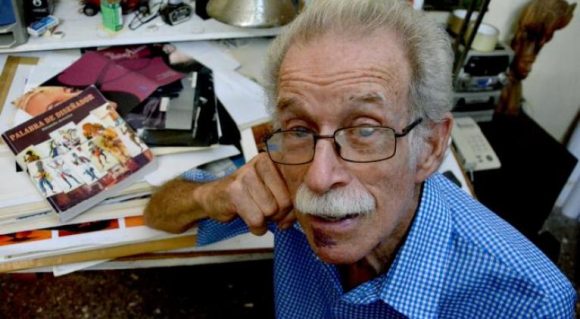The outstanding designer and painter Eduardo Arrocha, one of the most important figures of the performing arts in Cuba, passed away on Tuesday in Havana. With a career spanning more than six decades, Arrocha left an indelible mark on several theatre and dance groups, particularly Danza Contemporánea de Cuba, a company to which he dedicated a large part of his creative career.
His work, which combined profound artistic knowledge with inexhaustible creativity, marked a before and after in stage and costume design in the country. He was the teacher of entire classes of professionals in this field. In fact, few Cuban designers have been the protagonists of so many milestones in the performing arts. Few have found that perfect symbiosis between movement, lyrical proposal and plastic framework. Arrocha is a classic.
Born on 17 May 1934 in Havana, he graduated in 1959 with a degree in painting from the San Alejandro Academy of Fine Arts. His training was enriched by studies in scenic design and painting under the tutelage of masters such as Rubén Vigón, Agustín Fernández and René Portocarrero.
In the 1960s he had contacts with European professors, which cemented his style, characterised by careful attention to detail, a unique sensitivity, a determined investigative vocation and the ability to integrate visuality with the spirit of the works he designed.
He produced hundreds of stage, costume and lighting designs for theatre, dance, opera, film and television. He worked with the most prestigious artistic collectives in Cuba. There is no major Cuban dance company that has not used his creations. One of the most celebrated designs for Swan Lake for the Ballet Nacional de Cuba is his work. Or the Giselle that won the Grand Prix de la Villa de Paris. He also designed for the National Folkloric Ensemble, the Camagüey Ballet, for musical performances and for important theatrical groups.
A close collaborator of maestro Ramiro Guerra, he was one of the main references of the great movement of modern Cuban dance. This duo achieved a perfect confluence in the creative processes they undertook. And they achieved this through an intense dialogue and a shared notion of culture. Maestro Isidro Rolando has said it: Ramiro created Cuban modern dance and Arrocha gave it colour.
Some of their works explored unknown paths for stage design in Cuba, such as Ramiro’s famous Medea y los negreros, which broke with the conventions of stage representation. Arrocha was also the designer of emblematic works such as Súlkary and Okantomí.
His art crossed borders, he participated in international productions in Mexico, Bulgaria, Poland and Austria, and in prestigious events such as the Prague Stage Design Quadrennials.
Recognised both in Cuba and abroad, he received numerous awards, including the National Theatre Prize (2007), the National Design Prize (2013) and the National Dance Prize (2022), as well as the Alejo Carpentier Order.
His legacy goes beyond his countless creations; Arrocha trained generations of artists and contributed significantly to Cuba’s cultural projection in the world. He was a kind, cultured man, a lover of good conversation, open to exchange.
Today, Cuban culture bids farewell to a titan, whose work will continue to set the pace on the stage. He is a great example of how design can make the theatrical experience a singular experience, from the plastic projection. Arrocha is an unavoidable figure in Cuban culture.
(Taken from Cubasí)




